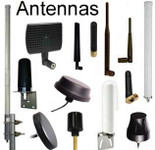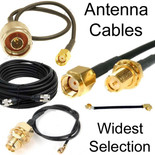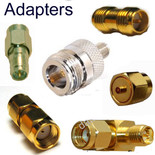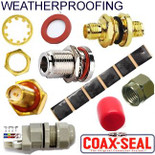Antennas, Antenna Cables, Wireless Products: Technical Articles
IoT Antenna Miniaturization Advances for Optimal Efficiency
Table of Contents
Advancements in IoT Antenna Miniaturization for Optimal Performance
Antenna miniaturization plays a critical role in enabling IoT devices to maintain high performance despite their reduced size. This article explores recent advancements in antenna miniaturization and how they address the challenges of performance, efficiency, and integration in IoT applications.
The Importance of Antenna Miniaturization
IoT devices often operate in constrained environments where space, power, and weight are critical considerations. Antennas, as vital components for wireless communication, must be miniaturized to fit within compact devices while maintaining optimal performance. Key challenges include:
Frequency Efficiency: Smaller antennas must operate efficiently across a wide range of frequencies, from sub-GHz to millimeter-wave bands.
Signal Integrity: Reduced antenna size can lead to lower gain and compromised signal quality.
Integration Challenges: Miniaturized antennas must coexist with other electronic components without causing interference.
Recent Advancements in Antenna Miniaturization
1. Metamaterials and Metasurfaces
Metamaterials are engineered structures with unique electromagnetic properties that enable antennas to operate efficiently at reduced sizes. By manipulating the dielectric and magnetic properties, metamaterials can enhance radiation efficiency and bandwidth.
Applications: Compact antennas for wearable devices and low-power IoT sensors.
Advantages: High efficiency, multi-band operation, and improved gain.
2. Fractal Antennas
Fractal geometries use self-similar patterns to maximize the surface area within a small footprint. These antennas are capable of operating at multiple frequencies, making them ideal for IoT devices requiring multi-band connectivity.
Applications: Smart meters, asset trackers, and IoT hubs.
Advantages: Compact design, multi-frequency support, and scalability.
3. Planar Inverted-F Antennas (PIFA)
PIFA designs are widely used in IoT devices due to their low profile and efficiency. Recent advancements include optimized substrate materials and integration techniques to further reduce size.
Applications: Mobile devices, smart home systems, and industrial IoT.
Advantages: Compact, cost-effective, and easy to integrate.
4. 3D-Printed Antennas
Additive manufacturing has enabled the creation of complex antenna designs that are both lightweight and space-efficient. By using advanced materials, 3D printing allows for precise control over antenna geometry and performance.
Applications: Custom IoT solutions for aerospace, healthcare, and automotive industries.
Advantages: Rapid prototyping, tailored designs, and material efficiency.
5. Embedded Antennas
Embedded antennas are integrated directly into the PCB of IoT devices, minimizing space requirements. Advances in simulation and manufacturing techniques have improved the performance of these antennas.
Applications: Wearable technology, smart appliances, and medical devices.
Advantages: Seamless integration, reduced size, and cost-effectiveness.
Future Directions
The evolution of antenna miniaturization continues to be driven by advancements in materials science, simulation tools, and manufacturing techniques. Future trends include:
Nanoantennas: Leveraging nanotechnology to create antennas capable of operating at terahertz frequencies.
AI-Optimized Designs: Using artificial intelligence and machine learning to optimize antenna designs for specific IoT applications.
Energy Harvesting Integration: Combining miniaturized antennas with energy harvesting technologies to power IoT devices sustainably.
Conclusion
Antenna miniaturization is at the forefront of IoT innovation, enabling smaller, more efficient devices to connect seamlessly across networks. From metamaterials to 3D printing, recent advancements have overcome many challenges, paving the way for enhanced performance without compromising size. As IoT adoption accelerates, continued investment in antenna research and development will ensure that the next generation of devices remains compact, powerful, and interconnected.
The Internet of Things (IoT) is revolutionizing industries, connecting billions of devices across the globe. As IoT devices become smaller and more ubiquitous, the need for compact yet efficient antennas has grown exponentially.
FAQs
Is antenna miniaturization important for IoT devices?
Antenna miniaturization is crucial because IoT devices often operate in space-constrained environments where size, weight, and power efficiency are critical. Smaller antennas enable compact designs while maintaining strong wireless connectivity.
What are the main challenges of antenna miniaturization?
Key challenges include ensuring frequency efficiency across multiple bands, preserving signal integrity despite reduced size, and avoiding interference during integration with other electronic components.
How do metamaterials and metasurfaces improve miniaturized antennas?
Metamaterials enhance radiation efficiency and bandwidth by manipulating electromagnetic properties. They enable compact antennas with higher efficiency, multi-band operation, and improved gain, ideal for wearables and IoT sensors.
What are the advantages of fractal antennas in IoT applications?
Fractal antennas use self-similar patterns to maximize surface area, allowing operation at multiple frequencies. Their benefits include compactness, scalability, and strong multi-frequency support, making them suitable for smart meters, asset trackers, and IoT hubs.
How are 3D-printed and embedded antennas changing IoT design?
3D-printed antennas allow precise, lightweight, and customizable designs for industries like aerospace and healthcare. Embedded antennas, built directly into PCBs, save space and reduce cost while seamlessly integrating into wearables, appliances, and medical devices.
What future trends are shaping antenna miniaturization?
Future innovations include nanoantennas for terahertz frequencies, AI-optimized designs tailored for specific IoT applications, and integration with energy-harvesting technologies for sustainable power solutions.







